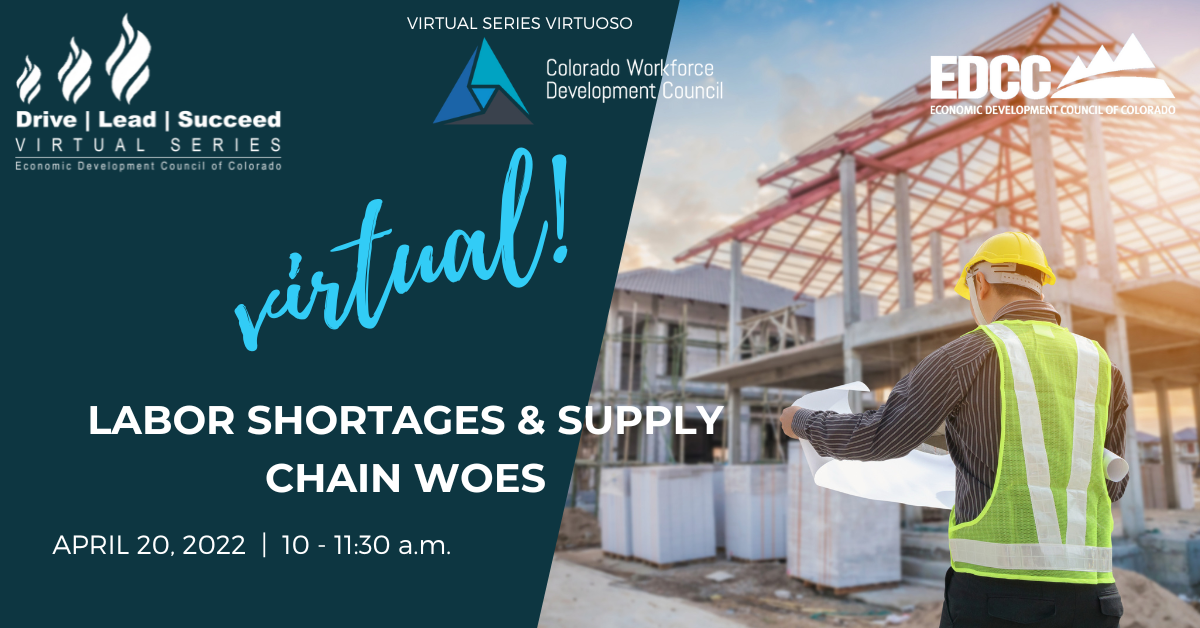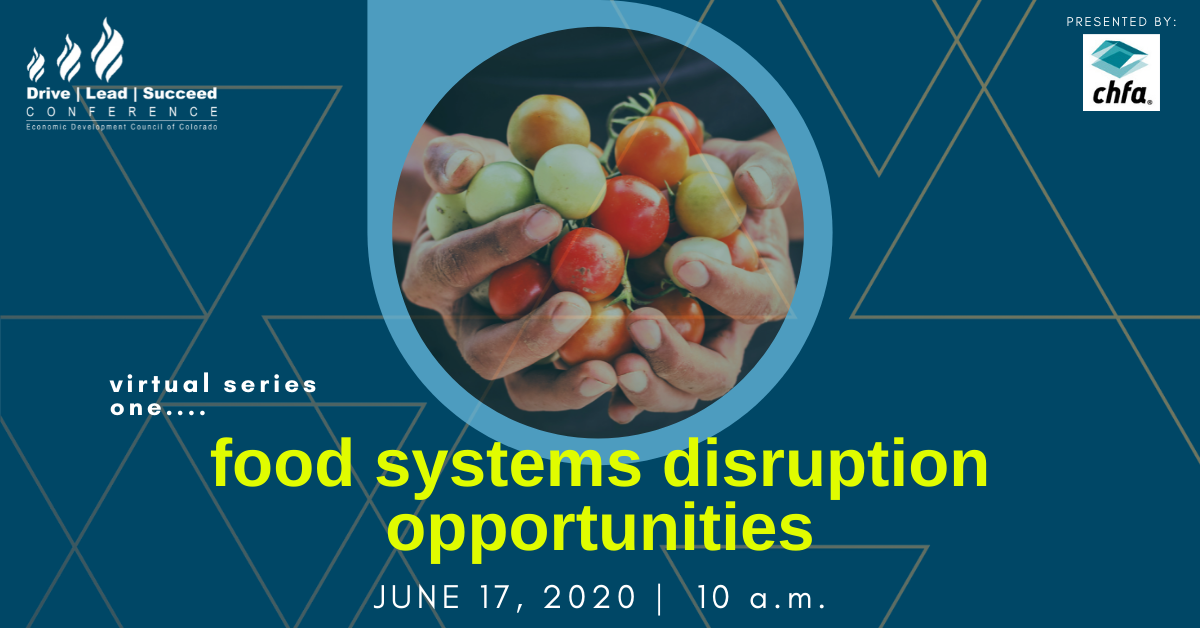Outcomes – Supply Chain Interruption

Outcomes – Supply Chain Interruption
MAIN SESSION HIGHLIGHTS
Manufacturer’s EDGE:
Manufacturer’s Edge encourages the strength and competitiveness of Colorado manufacturers through coaching, training, and consulting, collaboration-focused industry programs, and by leveraging government, university, and economic development partnerships.
Through onsite support and technical assistance, Manufacturer’s Edge works to boost the competitiveness of Colorado manufacturers. The experienced engineers and business professionals at Manufacturer’s Edge have skills in manufacturing, management, process improvements, and technology acceleration and work closely with manufacturers to provide company assessments and customized solutions including hands-on facilitation and implementation.
Current challenges with our manufacturing sector:
- Manufacturer’s were able to get through the extended first wave of the pandemic, but if they have to close down a second time, most of them might not make it.
- We need to find out what they need and help them get it
- We may know who our manufacturers are, but do we know everything about what they do? What machinery and capabilities do they have? Can they help fill in a gap for another manufacturer in the state?
- We need a robust database that helps us make these connections and helps us understand the depth of the manufacturing sector; what do we have, what do not we have, and fill the gaps
World Trade Center Denver:
World Trade Center Denver is a business network and services organization whose purpose is to help local companies find and execute new market potential across seas. WTC Denver helps members collaborate locally, connect strategically, and thrive on the global stage. By inspiring Colorado businesses and entrepreneurs to think bigger, WTC Denver helps forge ties with neighbors around the world and brings economic prosperity to Colorado through global trade.
- Challenges in supply chains before COVID
– Trade policy unpredictability
> Tariffs are going up
> Free trade agreements are unpredictable
> Ongoing sanctions
> Unpredictable planning and forecasting environment
> International business is a long-term game. It takes time, patience, and relationship building. If the environment is unstable then the long term game becomes even longer
– Importers are experiencing increased costs for steel and aluminum as well as components coming from Asian markets
– The goal behind increasing tariffs was to bring manufacturing back to the United States. The truth is, that companies do not make strategic decisions based on a tax/tariff.
These decisions are based on operational costs, long-term strategies, labor costs, or rules of law. Tariffs only create a temporary pain point for the company. If a company is strategizing 10 years out, then short blimps like tariffs are not a concern. - How did COVID exacerbate supply chain gaps
– 80% of all PPE is made in Wuhan, China. When the pandemic hit, plants shut down, it affected the world’s supply of PPE.
– As the pandemic spread through China, other plants began to shut down. The US is dependent on a lot of components and parts that are manufactured in China that then go
into the finished product here.
– Finding new sources to fill these gaps do not happen overnight. Sourcing begins with long-term relationships and quantity of your order.
– Increased logistics costs due to port closures and a lack of transportation. When shipping turned down their volume then the cost of transportation went up
– Elimination of travel; 1) now companies cannot go to trade shows to find news sales, suppliers, or distributers, 2) can’t send goods via air - Where are we now
– Risk mitigation: Companies are finding new markets, to help fill these needs
– Tariffs: are being considered again on steel and aluminum as well as wine, cheese, and olives. This hurts the consumer as well as the restaurant industry that is trying to open
again
– Talks of on-shoring: On-shoring is a difficult thing to do especially when so many of our resources for specialized components cannot be found here. Near-shoring is a
possibility. The possibility of moving some Asian manufacturing to Mexico may make sense for some companies. It is also closer to our time zone making logistics easier
– Location does matter: changing location of manufacturing to be closer to the customer base helps decrease transportation costs - What can the Economic Development community do to help?
– Celebrate and support companies no matter what they are doing to keep their doors open.
– As economic developers we need to support importers just as much as exporters and foreign direct investment. Companies like OtterBox employ over a 100 people and put
money back into the economy just the same
– Find new markets internationally. After a recession they are going to be desperate to sell more. 95% of the population and 70% of the purchasing power is outside of the U.S.
yet 5% of US companies export.
– Innovation and technology are disrupting companies and jobs more than trade does. How can we become more innovative, work smarter and with fewer resources
– Economic Development can support and promote the long-term strategies by driving down the cost to do business operationally as well as creating a predictable regulatory
environment. This helps companies’ competitiveness
REGIONAL BREAKOUT OUTCOMES
Northwest and Southwest Breakout: WATCH RECORDING HERE
Led by: Janine Ledingham and Cindy Nowak, Manufacturer’s EDGE
- How can we help newer businesses find local, state, or national suppliers
- How can we partner better to link supply chains in our state; identify supply chain gaps; and fill need supply chain gaps
- When looking at filling supply chain gaps, does it make sense to bring the supplier closer to the manufacturing facility or do we make the connection to one along the front range
- The western slope is home to many ag-based manufacturer’s like wine, produce, hemp, etc. How can we help better prepare them for higher costs in tariff’s and transportation
- Talent is hard to find. How do we keep the talent by finding things for them to do during the decrease in demand
- Businesses are in demand for trained and certified employees; how do we fill the pipeline?
- How can we create a focus group that can identify manufacturer’s, their capabilities, their supply chain needs, and help find new markets
- Inventory fluxes are occurring; how can economic developers inventory types of short-term flex space to help manufacturer’s handle influxes of inventory
- SLV Resource Group is a resource for funding and make new products
Southeast Breakout: WATCH RECORDING HERE
Led by: Tom Bugnitz, Manufacturer’s EDGE
- Survive and thrive: figure out what companies need and find it for them. They are going to need this assistance to survive the second wave if we have one
- Going back to what capabilities our manufacturer’s have. For example, we have a company in the metro area looking for a DC motor which is only made in Asia and its not available. Is there any other manufacturer in the U.S. who could supply that for him at a decent cost, and quickly?
- Economic Developer’s job description should expand to “Supplier Scouting,” locally and nationally. You know your businesses best; we have the national contacts.
- Building culture and network around a statewide database. How do you use the tool for economic development opportunities and wealth creation
Metro Denver Breakout: WATCH RECORDING HERE
Led by: Karen Gerwitz, World Trade Center Denver
- Permitting delays: companies experiencing high growth due to increased demand cannot grow due to the permitting processes
- Workforce shortages: high demand for machinists, welders, cut and sew specialists, etc.
- Creating a pivot mentality: pushing manufacturers to use their goods and services in ways they have not before. Example: a manufacturer is now using hemp fiber to produce plastics
- Databases can be static without fostering the culture and use of it. How can economic developers facilitate the needed connections to get this off the ground
- Buy local can also mean supporting our importers who import parts that finish of their goods
- What is needed to become a competitive global trading hub? What as economic developers, need to think about, when we are planning for the future and how does it compare to other trading hubs around the world?
Northeast Breakout: WATCH RECORDING HERE
Led by: Jessica Cowden, Manufacturer’s EDGE
- What our manufacturing community is already doing to help fill supply needs is a great win and hope that in continues but we need to do more
- More communication: We all need to come together collaboratively through forums or focus groups, discuss the needs, and how to fulfill those needs. We need to find a more formal way to convene
- The Northeast is relying heavily on their sector partnerships right now
- CSU is identifying opportunities and finding ways to support craft breweries, restaurants, meat packing plants
You may also like the following:
Manufacturer’s EDGE Important Links:
- COVID-19 Updates and Resources for Manufacturers
- Stay Safe. Stay Open. Product & Services Guide
- Manufacturer’s EDGE Services
World Trade Center Denver Important Links:
Read More







